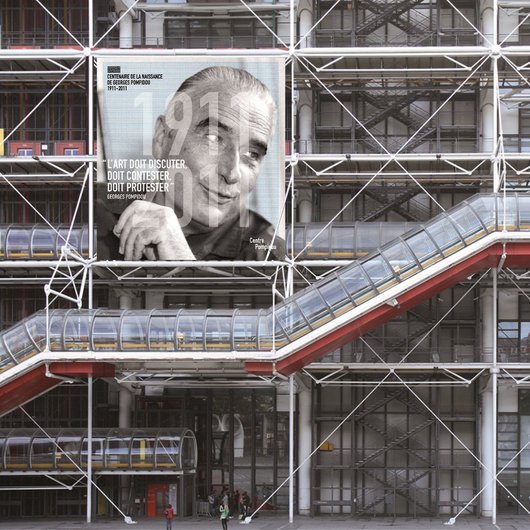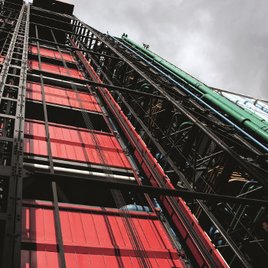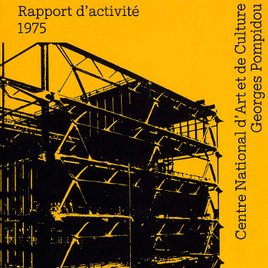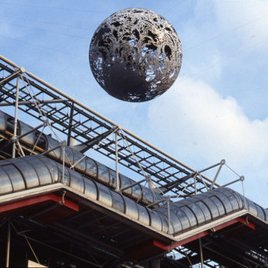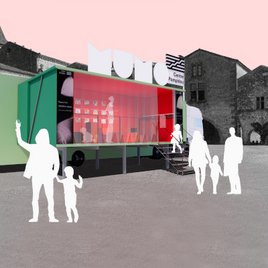Who are we?
A vocation, art for all
In 1969, President Georges Pompidou decided to provide France with a venue like no other: a centre for art and culture capable of housing both the National Museum of Modern and Contemporary Art, with an international dimension, a large public library (the future Bpi), a centre for industrial creation and a centre for musical research and creation (Ircam), all together in one and the same building situated in the heart of the capital. As great art lovers, the president and his wife were also ardent advocates of the democratisation of art. For Claude and Georges Pompidou, the Centre Pompidou had to be a place where all disciplines could meet, where artists could converse with the public. It also had to support emerging scenes and introduce and provoke debate. The titanic construction works began in May 1972 with two young architects, Renzo Piano and Richard Rogers, at the helm. Alas, the president died in 1974 before he could see the Centre Pompidou completed. It was inaugurated by his successor Valery Giscard d'Estaing in the presence of his wife Claude Pompidou on 31 January 1977.
It was an immediate success as soon as it opened. Whether people came out of curiosity, as amateurs or specialists, from close at hand or farther afield, the Centre Pompidou welcomed everyone. The venue saw itself as a "cultural machine" abolishing the frontiers between disciplines and between generations, and quickly became one of the five most-visited monuments in Paris.
The foremost collection of modern and contemporary art in Europe
Built up patiently over the years, today the collection of modern and contemporary art brings together more than 120,000 works. It is the richest collection in Europe and the second in the world. Joseph Beuys, Louise Bourgeois, Constantin Brancusi, Marc Chagall, Robert and Sonia Delaunay, Otto Dix, Jean Dubuffet, Marcel Duchamp, Frida Kahlo, Wassily Kandinsky, Yves Klein, Fernand Léger, Henri Matisse, Annette Messager, Joan Miro, Piet Mondrian, Jean Prouvé, Niki de Saint-Phalle, Xavier Veilhan, and so many more!
On levels 4 and 5, the works in the collection provide a unique immersive experience that unfolds the thread of the formal and aesthetic research at the root of modern and contemporary art, with the exhibition entirely renewed every two years and regular rotations of the works on display. These rotations enable the rooms to be renewed without altering the historical references. Through rooms and passages, corridors and aisles, a tour of the museum reveals the diversity of the collection and the range of creativity in all practices: photography, moving images, painting, sculpture, design, architecture, experimental film and video. Enriched in the course of time with new acquisitions and notably supported by generous donations, the collections never cease to grow, opening up to new scenes. This is the goal of the forward-looking work conducted by curators since 2000 in order to keep abreast of the globalisation of art and the growing number of contemporary scenes, reaching out to former East European countries, the Middle East, North Africa, Latin America and, more recently, South Asia and China, as well as Western Africa and South Africa.
An unparalleled collection, exceptional monographs and spectacular exhibitions have made the Centre Pompidou an essential destination in the art world, with more than three million visits every year. Among the exhibitions that marked their time, we find "Paris-New York", "Paris-Moscow" and "Paris-Berlin" (1977-1981), "Manifesto" (1992), "elles@centrepompidou" (2009); not forgetting highly successful monographs like those devoted to Pierre Soulages in 2009, Salvador Dali in 2013, Jeff Koons in 2014 and René Magritte in 2016 or, more recently (2019) Francis Bacon, which attracted between 500 and 800 thousand visitors.
A centre at the crossroads of disciplines
Film, whether in the movie houses or in the museum, is also very present in the Centre Pompidou in the form of exhibitions, festivals (e.g. Hors Pistes, Cinéma du Réel), or retrospectives devoted to renowned or yet to be (re)discovered directors. The "Grande Salle" and the "Petite Salle" are used to host live performances, with dance, concerts, performance art, theatre, etc. presenting contemporary creation in all its diversity. In addition, they host conferences and debates which can also be held in the Forum.
These activities in the field of live shows, the spoken word, film and performance art, are orchestrated by the Culture and Creation Department. True to its vocation as a place for thought and experimentation, the Centre Pompidou develops a forward-looking approach in each of these domains, keeping abreast of renewals in form and intersections in their approaches. In close collaboration with the Musée National d'Art Moderne, but also with the Ircam and the Public Information Library, it establishes links between contemporary artistic practices and the latest in the world of ideas, contributing to making the Centre Pompidou a place of exchange and debate where knowledge and creativity come together in dialogue.
Statement of commitments
For the Centre Pompidou, stating its commitments is to provide a reminder of its original vocation: more than forty years ago, the very creation of a centre for art and culture in tune with the changes of its time anticipated the movements which, on every side, now call on cultural institutions to reflect the underlying movements in today's society.
The Centre Pompidou's primary commitment relates to creation: enabling a maximum number of people to discover modern and contemporary works through exceptional exhibitions, by supporting emerging creation and presenting a forward-looking programme based on the freedom and creativity of the artists.
Lines run out from this primary commitment, lines that are sinuous because they weave between highly varied forms and disciplines (a question raised by an exhibition here may refer to a performance there, elsewhere a cycle of encounters, a concert or a retrospective). These lines, which sometimes come together just as today's issues are telescoped, criss-cross the surface of the programme while simultaneously pervading the very operating of the institution like so many milestones in a long-term project.
The environmental emergency, the fight against racism and discrimination, inter-gender equality and respect, along with social cohesion and knowledge sharing, are the lines of today.
Deriving their roots from the very history of the Centre Pompidou, these lines of commitment trace trajectories and landmarks that make the Centre a place that is always profoundly in resonance with society.
Young audiences and cultural mediation: outreach
As soon as it opened, the Centre Pompidou was the first institution to propose activities and exhibitions designed specifically for younger audiences. A programme entirely designed for children is presented in the Children's Gallery, in the different kids' workshops and in Studio 13/16, a zone dedicated to adolescents and their practices.
Whether written or oral, mediation is based on two essential values: experiences of artistic practice and encounters with artists. Visits, workshops, thematic cycles, master classes and festive events facilitate this shared experience in direct contact with young and adult audiences in the Centre Pompidou and beyond its walls, thanks to a vast programme of actions in other regions.
This quest for proximity with a maximum number of people is also increasingly supported and amplified by innovation and the deployment of digital offers. The Internet site thus provides free and easy access to the whole collection, enriched teaching and cultural resources, new visiting experiences and a multiplicity of possibilities for sharing and exchange.
The Centre Pompidou, beyond the walls
The Centre Pompidou is present in Metz, Malaga, Brussels and Shanghai, reaching out beyond its Parisian confines to new regions and new audiences. True to its spirit of openness and wishing to share its collection and know-how, it conducts many actions both on a national and international level.
Internationally, the Centre Pompidou deploys a unique development model consisting in "co-constructing" with partners, for a period of 5 to 10 years, projects that take account of local features and expectations rather than establishing subsidiaries. The partners manage the running of the site and the Centre Pompidou, in close consultation with the partners, designs the cultural programme, bringing its expertise and consultancy skills to bear in the field of conservation, mediation and educational action.
In addition to these operations, the Centre Pompidou also designs specific exhibitions outside France for partners and naturally assists when these exhibitions travel. Every year, some 6,000 loans and 6,000 deposits are also organised throughout the world.
Equally essential, the projects conducted on French soil testify to its desire to reach out ever more to its audiences, to invest more in the social domain and to promote access to art and culture for a maximum number of people.
The Centre Pompidou-Metz is a good example of this local presence; it remains the most visited centre of modern and contemporary art in France, outside the Paris region. Mille formes, the first centre for introducing art to 0-6 year-olds, also contributes to this dynamic. The "1 day, 1 art work", the "Fabrique Mobile" and the "Saule et les hoopies" roving merry-go-round projects, to mention but a few, present works in everyday locations and promote an awareness of art in a young audience.
Expertise and consultancy
The Centre Pompidou whose know-how is recognised throughout the world helps companies, associations, cultural institutions and local communities, in France and internationally, to implement different cultural engineering projects and with their training activities.
Convinced that dialogue between today's companies and artistic creation enables us to have a better grasp of tomorrow's world and to prepare for it, the Centre Pompidou also created the Centre Pompidou Accélérations Endowment Fund in order to work with companies that wish to engage closely with the artistic world and Centre Pompidou teams and audiences.
